Peace
Timeline : 2000
Pre-1999
| 1999 | 2001
| 2002
December
29, 2000
 Diego
Turbay, a Colombian legislator who headed a congressional peace
committee, is assassinated along with his mother and five other
people on a highway in southern Caquetá department, not far
from the FARC demilitarized zone. The assassination is widely attributed
to the FARC, casting further doubt on the future of peace talks. Diego
Turbay, a Colombian legislator who headed a congressional peace
committee, is assassinated along with his mother and five other
people on a highway in southern Caquetá department, not far
from the FARC demilitarized zone. The assassination is widely attributed
to the FARC, casting further doubt on the future of peace talks. |
December
23, 2000
As an
act of goodwill, the ELN releases forty-two police and military officials
it had taken hostage.
December
15, 2000
A prominent
union leader, Federation of State Workers President Wilson Borja, is
wounded in a shootout that kills two people.
December
12, 2000
Colombian
Army chief Gen. Jorge Mora declares that the Army is prepared to reclaim
the FARC demilitarized zone whenever it is called upon to do so.
December
8, 2000
| The
second of three U.S.-created Colombian Army counternarcotics battalions
"graduates" at a ceremony in Larandia, Caquetá
department. |
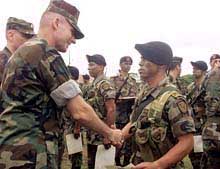
Gen. Peter Pace, head of the U.S. Southern Command, congratulates
a graduate. (Associated Press photo) |
December
6, 2000
Though
the FARC maintains its freeze on the talks, President Pastrana announces
that the guerrillas' despeje (demilitarized) zone is extended
until January 31, 2001.
December
1, 2000
Camilo
Gomez, Colombia's chief peace negotiator, meets FARC leader Manuel Marulanda
though the talks remain officially "frozen."
November
29, 2000
Carlos
Julio Rosas, mayor of Orito, Putumayo, is assassinated. He is the seventeenth
Colombian mayor killed this year.
November
28, 2000
U.S.
Senator Paul Wellstone, a critic of the military component of the U.S.
aid package, visits Colombia. While in Colombia, Wellstone observes
the spraying of coca fields and travels to Barrancabermeja for a meeting
with human rights defenders.
November
19-21, 2000
A delegation
of U.S. officials meet government representatives for talks about implementation
of the U.S. aid package.
November
15, 2000
The FARC
declares a unilateral "freeze" on the peace process. The guerrillas
say they are suspending the talks until the government takes firmer
measures against paramilitary groups.
November
14, 2000
 Rep.
Benjamin Gilman, R-N.Y., a key congressional supporter of the aid
package, declares the U.S. aid package "a major mistake"
in a letter
to anti-drug chief Barry McCaffrey. Rep.
Benjamin Gilman, R-N.Y., a key congressional supporter of the aid
package, declares the U.S. aid package "a major mistake"
in a letter
to anti-drug chief Barry McCaffrey. |
November
9, 2000
Paramilitaries
free the last of the legislators they have kidnapped, after Interior
Minister Humberto de la Calle meets with AUC leader Carlos Castaño.
November
1, 2000
The last
of the hostages taken by the ELN on September 10 is released.
October
29, 2000
Elections
are held for both municipal and departmental posts. Officials said that
aside from isolated fighting between members of the FARC and army troops
in the outlying provinces, voting was carried out with no major disruptions.
October
26, 2000
More
than six weeks after the Arnubio Ramos hijacking, government and rebel
representatives resume talks. Discussions of a possible cease-fire lead
the agenda.
October
25, 2000
Paramilitaries
kidnap three members of Colombia's Congress, bringing to six the number
of legislators abducted during the past week. The kidnappings take place
days before October 29 regional and local elections.
October
19, 2000
Four
FARC units launch attacks on Dabeiba, Antioquia, and Bagadó,
Chocó. The upsurge in fighting comes before nationwide local
elections.
October
17-19, 2000
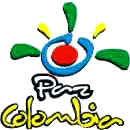 More
than 300 people meet in Costa Rica for a three-day meeting known
as "Paz Colombia." The meeting aims to increase civil-society
participation in peace efforts and to come to agreement on alternatives
to the "Plan Colombia." More
than 300 people meet in Costa Rica for a three-day meeting known
as "Paz Colombia." The meeting aims to increase civil-society
participation in peace efforts and to come to agreement on alternatives
to the "Plan Colombia."
The meeting brought together representatives from the Colombian
government, civil society and one of the largest leftist rebel groups,
the National Liberation Army (ELN). |
September
24, 2000
The
FARC calls an "armed strike" in the southern deparment of
Putumayo, where the U.S.-funded anti-drug offensive is to take place.
Demanding an end to the Plan Colombia's military component, the guerrillas
prohibit all vehicle traffic on Putumayo's roads. As a result, isolated
towns and hamlets suffer severe shortages of food, gasoline and drinking
water. The strike lasts until early December, when the FARC unilaterally
lifts it.
September
10, 2000
The ELN
kidnaps at least 50 people along a main road on the outskirts of Cali.
The hostages are freed a few weeks later.
September
8, 2000
A FARC
guerrilla named Arnubio Ramos hijacks a commuter airliner and forces
it to land in San Vicente del Caguán in the FARC demilitarized
zone. Government officials insist that the guerrillas turn Ramos over
as an indication of their commitment to the peace process. The guerrillas
refuse to hand him over, arguing that Ramos hijacked the plane on his
own account and "the FARC bears no responsibility."
August 30,
2000
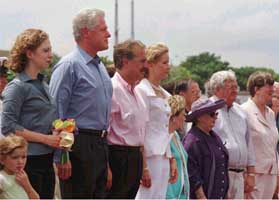 President
Clinton arrives in Cartagena, Colombia for a one-day visit with
a delegation of U.S. lawmakers, Cabinet members and diplomats. President
Clinton arrives in Cartagena, Colombia for a one-day visit with
a delegation of U.S. lawmakers, Cabinet members and diplomats. |
August 23,
2000
President
Clinton issued a determination
waiving all but one of the human rights conditions in the aid package.
This step allowed most military assistance to begin flowing.
August 9,
2000
President
Andrés Pastrana met with U.S. Undersecretary of State Thomas
Pickering and White House Office of National Drug Control Policy Director
Gen. Barry McCaffrey, to discuss preparations for President Clinton's
first visit to Colombia Aug. 30. They also discussed implementation
of the $7.5 billion ``Plan Colombia.''
July 24-25,
2000
Colombian
government officials begin talks in Geneva, Switzerland with the ELN
to try to move the peace process forward. Approximately 80 Colombian
civil-society representatives also took part in the discussions.
July 13,
2000
President
Clinton signs into law H.R. 4425, which contains the aid
package for Colombia. This package totals $1.321 billion, about
65 percent of it -- $860.3 million -- for Colombia.
July 3,
2000
FARC
and government negotiators exchange cease-fire proposals in sealed
envelopes. Though the proposals are to be discussed after a one-month
analysis period, no progress toward a truce is made.
-
FARC
cease-fire proposal [English | Spanish]
June 29-30,
2000
More than
20 diplomats from Europe, Canada, Japan and the United Nations meet
in San Vicente del Caguán with Colombian officials and FARC leaders
to talk about alternatives to drug production. This is the first discussion
of drug policy since peace talks began.
June 28,
2000
A "conference
committee" made up of senators and representatives finishes
reconciling the differences between the House and Senate versions of
the Colombia aid package. Their approved
version of the Colombia aid package contains a different mix of
helicopters, a combination of the House and Senate human rights conditions
but with a waiver allowing the Secretary of State to skip the human
rights certification if doing so is in the "national security interest,"
cuts in the Senate's funding for human rights, removal of a House provision
increasing funding for internally displaced persons and removal of the
Senate's environmental conditions on herbicides. The conference report
goes to the President for his signature.
June 22,
2000
The U.S.
Senate
approves its version of the Colombia aid package (S. 2522) by a
95-4 vote.
June 18,
2000
Government
officials, the ELN, and the mayors of the proposed "encounter zone"
meet at the Serranía de San Lucas in Southern Bolivar.
May 17,
2000
President
Pastrana suspends peace talks with the FARC for several days after a
woman in Boyacá department was killed by a bomb placed around
her neck. It is the first time since the peace process began that the
government has suspended the talks. A few days later, the Colombian
government acknowledges that evidence does not indicate that the FARC
committed the crime.
May 9, 2000
The U.S.
aid package is presented in the Senate Appropriations Committee. The
committee's version contains less military aid and more human rights
funding and conditions. An amendment which would have cut about 90 percent
of the aid fails by a narrow margin.
April 26,
2000
|
Victor
G. Ricardo, the high commissioner for peace, announces his resignation.
While Ricardo said that he was leaving because the peace process
had reached "a point of no return," many observers speculated
that frequent death threats influenced his decision.
Camilo
Gómez, the president's private secretary and a member of
the government negotiating team, replaces Ricardo as high commissioner.
|
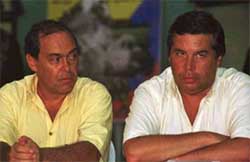
Gómez, left, with Ricardo.
|
April
25, 2000
The FARC's
military head, Jorge Briceño Suárez, el "Mono Jojoy",
announces that any person whose net worth exceeds 1 million dollars
would be "taxed" by the FARC.
|
April
25, 2000
Government
and ELN negotiators announce the creation of an "encounter
zone", located in the southern part of Bolivar and northeastern
part of Antioquia encompassing the municipalities of Cantagallo
and San Pablo in Bolívar and Yondó in Antioquia.
The security forces are to vacate these areas to facilitate dialogue
with the guerillas, though civil and judicial authorities will
continue to be present to guarantee the safety of the citizens.
This "encounter zone" will last approximately nine months
and will host peace negotiations and the National Convention that
has been proposed by the ELN since 1996. The agreement does not
establish mechanisms for creating the zone, which opposed by paramilitaries
active in the area and many local residents.
|

Approximate location of ELN "encounter zone"
|
April 13,
2000
Government
and FARC negotiators announce that a possible open-ended cease-fire
agreement is "on the table." Cease-fire discussions are to
take place behind closed doors, with confidential proposals. According
to reports, the FARC's proposal foresees a temporary cessation of hostilities
for a fixed period that can be extended. A bilateral government-FARC
commission would verify the agreement. The most difficult condition
in the FARC proposal is a demand that the cease-fire apply to all parties
to the conflict, including right-wing paramilitary groups.
April 12,
2000
The ELN
declares a temporary cease-fire for Easter week.
April 11-12,
2000
President
Pastrana travels to Washington to try to re-start U.S. congressional action
on the aid proposal. Sen. Lott assures Pastrana that the aid package will
be attached to the first available 2001 appropriations bill, and that
it will take effect immediately once signed into law. Lott says this could
happen as early as late May or early June.
April 9-11,
2000
The
FARC and Colombian government host a "Public Audience"
in Los Pozos, inviting Colombian organizations and citizens
to the demilitarized zone for an open discussion on "the
generation of employment." Though the meetings were marked
by tensions between representatives of unions and business groups,
both called on the FARC to implement a cease-fire, a halt to
kidnappings and respect for international humanitarian law in
the conflict.
|
|
March 29-30,
2000
The U.S.
House of Representatives passes an emergency supplemental appropriation
for 2000 that includes the administration's aid
proposal with few changes.
March
27, 2000
The FARC
earns widespread condemnation by carrying out a brutal attack in Vigía
del Fuerte, Chocó, killing 21 policemen and several civilians.
March
17, 2000
A group
including some of Colombia's most important businessmen (known colloquially
as "los cacaos") travels to the zone for a meeting
with Marulanda and the FARC leadership.
March
15, 2000
America
Online co-founder James Kimsey travels to the FARC demilitarized zone
for a meeting with Marulanda. The meeting's purpose is to educate the
guerrillas about the changes in the world economy wrought by new technologies
and international investment flows.
March
1, 2000
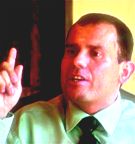
(From Semana magazine) |
In
a television interview seen by many as a public-relations effort,
paramilitary leader Carlos Castaño declares his "respect"
for the government-FARC peace process and says he favors the formation
of an "encounter zone" -- one municipality in Bolívar
or two in Córdoba -- for possible ELN talks. He calls as
well for the inclusion of paramilitary groups in peace talks.
In the interview, Castaño -- who shows his face for the
first time -- is unapologetic about paramilitary atrocities, and
again admits that his forces profit by taxing the drug trade.
|
February
11, 2000
Meeting
with government representatives, ELN leaders reiterate their request
to demilitarize a 6,000 square-kilometer zone in southern Bolivar department
to host subsequent peace talks.
February
6-12
The ELN
blockades the main highway between Bogotá and Medellín
for several days, demanding that the government demilitarize municipalities
in southern Bolívar department to hold peace talks. At the same
time, peasants in southern Bolívar -- reportedly encouraged by
paramilitaries -- block the main highway from Bogotá to the Caribbean
coast to protest a possible demilitarization of their area for ELN talks.
January
31- February 16, 2000
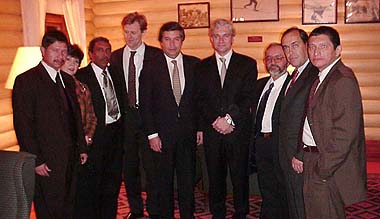
Peace
Commissioner Victor G. Ricardo and a delegation of FARC negotiators
travel to Sweden, Norway, Switzerland, Italy, France and Spain
on a "tour" facilitated by Jan Egeland, the special
representative for Colombia of UN Secretary-General Kofi Annan.
The trip's primary purpose is to inform the negotiations' discussion
of Colombia's economic model by familiarizing participants with
the mixed economies of Scandinavia and Western Europe. An unstated
secondary goal of the visit is to increase the FARC's exposure
to a changing world and the international community's expectations.
|
January
20, 2000
With Colombia's
economic model the first topic on the agenda, Finance Minister Juan
Camilo Restrepo travels to Los Pozos to meet Marulanda and seven other
FARC leaders. The purpose of their meeting is to evaluate the cost of
making peace and other economic issues, particularly unemployment.
January
13-16, 2000
Its Christmas
truce over, the FARC carries out attacks in Nariņo department and about
30 miles southeast of Bogota. The Bogota attack is successfully repelled
by the Colombian military.
January
11, 2000
The Clinton
Administration proposes a $1.273 billion, two-year package
of assistance for Colombia. About $1 billion of the package would add
new military and police assistance. The aid is to be submitted to Congress
for its approval.
 |
U.S.
Secretary of State Madeleine Albright pays a visit to Colombia January
14 and 15 to explain the proposed package to Colombian officials. |
January
13, 2000
Peace
talks with the FARC re-start. On January 14 FARC leader Marulanda pays
a surprise visit to the site of the talks in Los Pozos, Meta. Marulanda
voices optimism, stating that the talks are near the point at which
substantive negotiations, following the twelve-point
agenda agreed on May 6, 1999, may begin.
Pre-1999
| 1999 | 2001
| 2002
See
also:
"An Overview of Recent Colombian History,"
from the Colombia Human Rights Network website.
"Colombia: A
Country Study" - US Library of Congress
State
Department Background Notes: Colombia
CIA World
Factbook 1998: Colombia
CIP's
New and Noteworthy
Page, including links to current Colombia news
|

